Software without hardware
Tracy McGrady was the prototype for the modern NBA star wing. So why was he only a prototype?




Everything about the COVID-19 pandemic sucks, including (but not most importantly) the absence of live sports. This newsletter, like all other publications that need actual games for new content, became a basketball history publication by necessity. The one tiny silver lining is that researching the past has been a great way to appreciate current on-court trends that otherwise hide in plain sight.
For example, the emergence of so many tall, do-everything wings in the NBA is easy to take for granted within the flow of a season. Only by rewatching past games can one see how quickly this type of player has grown from luxury item to prerequisite for serious title contention.
Yes, prerequisite. Since Kobe Bryant earned the last of his five rings in 2010, eight of the last 10 Finals series and 16 of the past 20 conference championships have been won by LeBron James, Kawhi Leonard, or Kevin Durant. (Seventeen if you count last year’s Warriors, who lost Durant to injury. Fifteen if you don’t count the 2013 Spurs, who had a second-year Kawhi). Of the 13 teams over .500 this season, nine feature at least one elite, high volume, ball-dominant wing scorer. A 10th has Ben Simmons, who is all of those things except “scorer.”
This point seems obvious, but it’s also never been true in NBA history. The dominant big man was the ultimate player archetype for decades. After Michael Jordan broke through, the league fetishized the athletic, score-first off guard. The scoring point guard had its turn in the sun after hand-checking was eliminated. As recently as a couple years ago, “unicorn” big men were poised to rule the day.
Instead, today’s NBA is run by oversized wings who control entire teams’ supply lines as scorers, passers, and even defenders. The new NBA archetype is LeBron, Kawhi, KD, Giannis Antetokounmpo, James Harden, and Luka Doncic. To a lesser extent, it’s Simmons, Jayson Tatum, Pascal Siakam, Jimmy Butler, Paul George, and even Khris Middleton. They don’t play exactly the same, but they’re all from the same family.
In the past, the oversized wing was a curiosity within a sport that fetishized balanced scoring and clear division of labor. Today, they are the stars, and their style is considered normal, if not essential. What was once a distinct subculture within the game is now the new NBA normal. This is NBA Heliocentricism, to steal a term from friend-of-the-newsletter Seth Partnow.
And just like other grassroots movements that go mainstream, the culture of the giant do-everything wing perfected or appropriated (depending on your perspective) the work of a spiritual guide who innovated, disrupted the status quo, and then fizzled out before he could see the long-lasting benefits of his work. We can’t appreciate the key figures of this burgeoning new era without understanding why their prototype rose and fell so quickly.
His name was Tracy McGrady.
The accidental innovation
Tracy McGrady was never supposed to be the sun, moon, and stars of his teams. He was only beginning to emerge as the Robin to Vince Carter’s Batman, a role he publicly embraced while privately yearning for more. “We could be the next Jordan and Pippen,” T-Mac said, as relayed by NBC’s Ahmad Rashad. “And I would be Pippen.”
Scottie was a popular comparison. “We think he can be a scoring version of Scottie Pippen — and Scottie is a pretty good scorer," then-Magic coach Doc Rivers told Sports Illustrated before T-Mac’s first year in Orlando.
Ah yes, Orlando. That’s where McGrady signed after his third year in the league, thinking he’d be the Robin to Grant Hill’s Batman. (For a second, they both thought they’d be Robins to Tim Duncan). Instead, Hill suffered a series of horrific ankle injuries and only played 46 games in four years, leaving McGrady to carry a hopeless supporting cast. Even his Houston years were star-crossed: including playoffs, he only played with Yao Ming for 46 percent of the Rockets’ games from 2005-2010.
That’s a lot of games with Darrell Armstrong, Mike Miller, and Rafer Alston as his next-best perimeter shot creators. What choice did T-Mac’s coaches have but to turn their offense into Tracy and four guys spacing the floor for Tracy?
The upside of that bad fortune is that McGrady turned into an overnight star. He could score any way he wanted. Off the dribble, off the catch, it didn’t matter. He took and made shots nobody else even attempted. You could post him up …

Run him off screens …

Put him at the top of the key to run pick-and-roll …
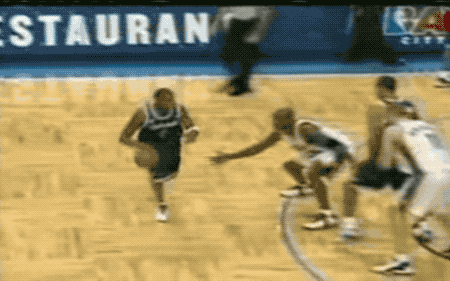
Or just leave him alone …

McGrady didn’t score all the time, but he always seemed to get the shot he wanted. When he couldn’t, he used his size, vision, and understanding of the floor spacing to find the right teammate at the exact right moment.

Yet it’s far too limiting to consider McGrady as an evolved Pippen, as so many did at the time. Pippen was a savant within the flow of the game and less of one when he had to begin from a standstill position. He was great at connecting and disrupting plays, but not as good at starting them.
McGrady, as it turned out, had the complete opposite disposition. His best attribute was anticipating the flow of the game, not reacting to it. He was most comfortable from a standstill position, where he could map the floor, run his calculations, and then act. The more controlled the on-court environment, the more McGrady’s rapid mental processing kicked in. As Armstrong once told SI, “Tracy wants to stop, look around and figure it all out.”
The best way to do that was to give him the ball over and over and over again. Orlando had little other choice anyway. And it was only with the ball in his hands and the other nine players awaiting his next move that McGrady’s superpower kicked in.
The fastest first step in the solar system
McGrady seemed to have an endless supply of moves in his bag. He had every kind of jumper, could pull-up from anywhere on the court, drive either way to finish, and manipulate the help defense to find the open man when trapped. Those impossible-to-stop set of skills were powered by a single key element: the ability to act first.
Nobody was better than McGrady at making the first meaningful move while the game was paused. By the time the defense reacted, McGrady either made the play he wanted or set up the sequence of counter-moves that would eventually supply the intended result.
The more McGrady controlled the offense, the more he could grind the game to a halt and use his most fundamental advantage. He would lull his defender to sleep in one-on-one situations with a series of jab steps in the mid-post or a few slow between-the-legs dribbles on the perimeter. That allowed him to spot the precise millisecond his defender’s hand dropped too far down to contest his rise-up jumper.

McGrady combined that precision with his leaping ability to get clear sight lines on jumpers that looked contested to the naked eye. Kenyon Martin may be standing close to McGrady, but he can’t get anywhere near McGrady’s eyes on the release of this shot.
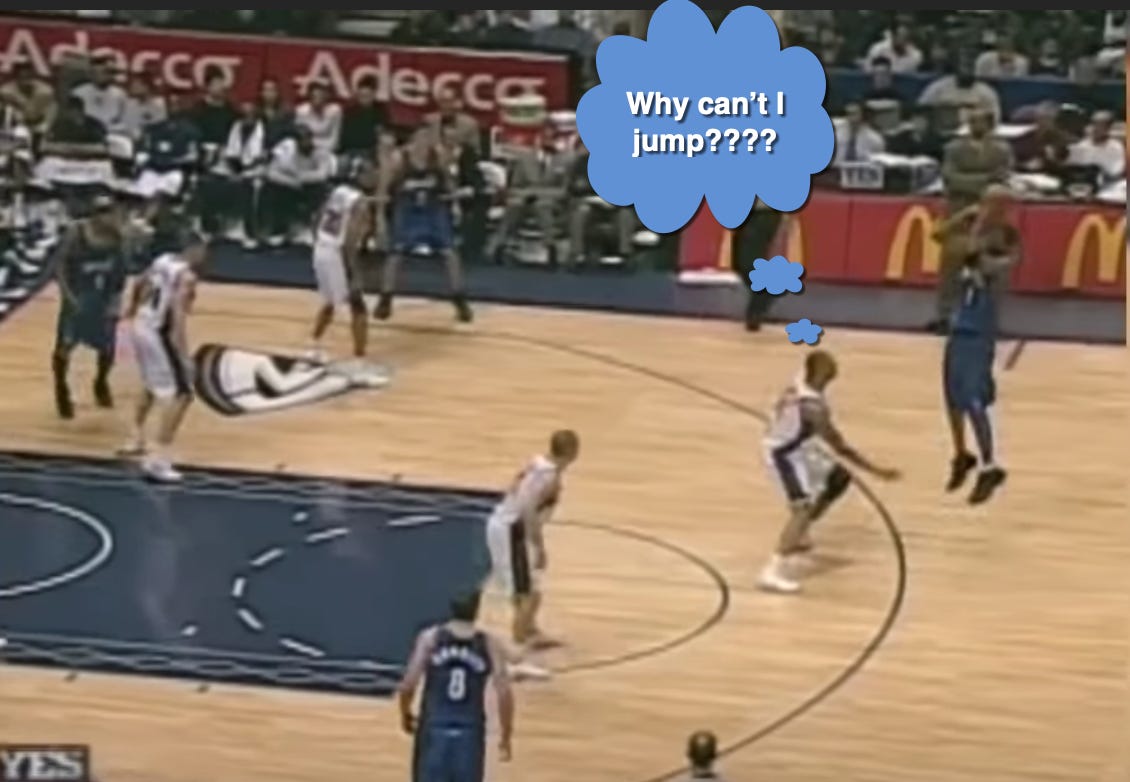

McGrady was looking at more than just arm position. He was also checking their hips to see which way they were leaning. Once he saw the slightest opening in their stance, he pounced, whether it was to pull up from 3.

Attack hard the other way.

Or hit ‘em with the stop-and-pop.
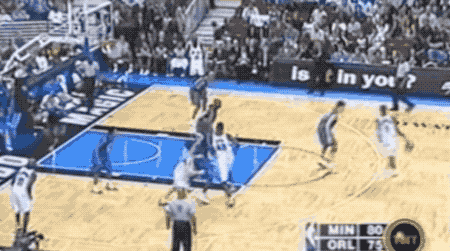
Like a pitcher who fools hitters with identical arm motions on his fastballs and off-speed pitches, McGrady adopted the same body posture before pull-up jumpers and drives. He pioneered the use of a “hang dribble,” using his size to let the ball dangle in mid-air as he studied the defense. Once his opponent inevitably flinched, McGrady snatched the ball out of mid-air to drive or pull up. It didn’t matter which hand he used or even where the ball was in its long bounce. He was a threat to strike quickly at any point within a six-foot-plus range.


As McGrady’s hang dribble hypnotized defenders, his feet shuffled into position. Like most explosive drivers, McGrady was adept at instantly getting low, scissoring his legs into a wide spread, then lifting his back foot slightly off the ground so he could push it forward with extra force.
Yet defenders couldn’t assume he was driving based on his foot position because he used the exact same motion to set up his rise-up jumpers. He could bring his back foot into a one-two step just as easily as he could advance it while surging to the basket.
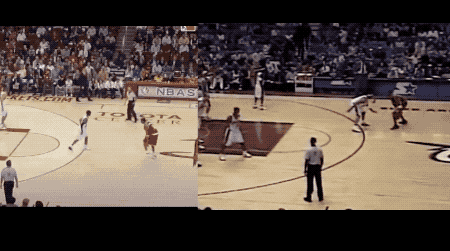
Between his dribble moves and footwork, McGrady gave himself extra time to read the floor before attacking. As everyone else waited, McGrady plotted out all the potential dominos that might fall based on his first move.
That also explains why McGrady was a pioneer of the jump pass. It was once considered a cardinal sin to leave your feet before making a pass-shoot decision, but McGrady was one of the first to turn it into a weapon. His size, elevation, and vision gave him more time to freeze defenders with his eyes, while his rapid processing system enabled him to spot the cues to make the right pass. He inspired many imitators, to the point where the jump pass has become an essential tool to beat any double-team.

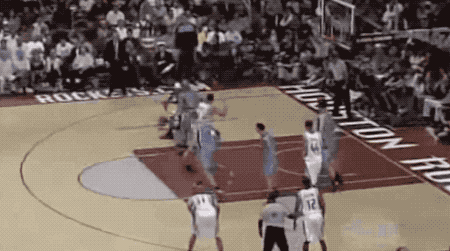
Athleticism and craft worked together in perfect harmony to maximize T-Mac’s Heliocentricism. His fast-twitch muscles moved faster than anyone else’s, but that’s because he knew exactly where to look. Nobody was better when the game stopped, which is why it made perfect sense to give him the ball and let him dictate the entire offense.
The one big fly in the ointment
If McGrady was accidentally placed in the perfect position for his game to thrive, why did his career seem like a disappointment?
There are plenty of factors beyond his control, starting with his famous inability to advance in the playoffs. This gets thrown back in McGrady’s face, but it says more about the quality of his teammates than him. After all, McGrady was one of the few stars who put up better numbers in the postseason. Even if the lack of talent around McGrady was an inevitable consequence of his Heliocentricism, it’s not McGrady’s fault that his superstar running maters were so often in street clothes.
He was also unlucky to arrive before NBA coaches knew knew how to maximize players like him. As I wrote for FiveThirtyEight, McGrady cost himself a ton of points by shooting loooooong twos instead of threes. That would’ve been corrected within today’s ingrained 3>2 culture. The Magic shot more spot-up threes than most teams of their era, but they still made it harder for McGrady to finish his drives with compressed floor spacing like this.

But there is a factor that was somewhat within his control. Ironically, it’s the one that most see as a cruel twist of fate.
The real reason McGrady’s career seems unfulfilling is that his own injuries prematurely cut it short. Those injuries didn’t happen by accident. They happened because McGrady’s biomechanics were abysmal.
Watch this video by Coleman Ayers, who runs the essential website and YouTube channel By Any Means Basketball.
That video dissects McGrady’s landing mechanics, which put too much strain on the wrong parts of his body. What goes up must come down, and what goes up really high comes down hard. McGrady’s leaping ability was crucial to his success, but it put his body in considerable peril.
The best way to land properly is to sink the hips in mid-air and fall softly on the balls of both feet at once. That enables the glute and calf muscles, two of the strongest in the body, to absorb most of the force of the drop.
That’s not always possible in a dynamic game like basketball, so players use other tricks to minimize the stress on their leg muscles. One is to chop their steps so one leg doesn’t need to catch the full force of the landing.

Another tactic is to, uh, actually fall. This may seem counterintuitive, but at least the weight of one’s full body cushions gravity better than a single leg can. This Ja Morant fall looks scary, but once his body got twisted in mid-air, it’s better he did this than try to land on his feet.
The worst possible way to land is on one foot with a straight leg. That forces the knees to absorb the brunt of the fall and causes them to protrude over the toe. That’s an unnatural position for the knee, which then affects the rest of the body. This is how non-contact knee and leg injuries happen. Just ask Derrick Rose.
Sadly, that’s how Tracy McGrady constantly landed, especially on those high-rise jumpers he came to love.



It’s hard to overstate the stress those landings put on his body. From 2000 to 2008, McGrady averaged 38.7 minutes per game in the regular season and 42.6 per contest in the playoffs, all while carrying the largest scoring load in the league. He spent a lot of time jumping and landing.
To figure out how much, I watched a random T-Mac playoff game — Game 2 vs. Milwaukee in 2001 — and jotted down every time he jumped and landed. He ended up leaving his feet 61 times in the game, often while leaping as high in the air as possible. I flagged nearly half of them as outright bad landings and very few as ideal ones. Now repeat that ratio over 600 games with his minutes load. Truthfully, it’s a wonder he wasn’t injured more often.
(Here’s the spreadsheet in case you want to view the date. The second tab is Paul George from a 2017 playoff game against Cleveland. I figured PG had a similar body type and minute load, and that Pacers supporting cast was of similar quality to McGrady’s in 2001).
Recognizing dangerous landings is one thing. Changing them is another. Perhaps McGrady could have fixed his if the league embraced the science of injury prevention sooner. Perhaps his poor practice habits would have been rebranded into rest opportunities instead of ridiculed by the “suck it up” culture that existed in his day. Perhaps proper load management could have added many more years to the back end of his career.
But McGrady’s landings were as much the result of poor biomechanics as they were the cause. He fell awkwardly because he lacked the core strength to control his body in mid-air.

Consider this alarming quote from Daniel Reavy, a biomechanics expert that worked with McGrady in 2009 after his microfracture surgery:
"His whole body was imbalanced from basically his shoulder blades down to his feet," Reavy says. "He was developing a lot of back problems ... He was developing strength in an imbalanced fashion. And what I see in Tracy, in general, he had no core strength, he couldn't hold a plank."
Or this line from John Patterson, a rehabilitation specialist that helped McGrady during his Rockets tenure:
"Everybody looks at his back, and they miss the fact that his head is pulled to the right, his right shoulder is dropped forward and when he goes to sit down, he puts his hands down to steady himself, which means he has very little leg strength," Patterson said.
McGrady was born with a slight case of scoliosis, which curves one’s spine and droops their posture. He also had flat feet, which makes it harder to land safely on the arch. He claims that doctors told him he’d have a short career because of these ailments — he said 5-6 years tops in a 2008 Health and Fitness Magazine feature, then amended that to four years in an interview with the Houston Chronicle. Honestly, it’s remarkable he played as long as he did given those handicaps. (The National Scoliosis Center lists him as a success story for overcoming the ailment, along with legendary sprinter Usain Bolt.)
But they also made it challenging for McGrady to improve his abdominal, glute, and calf muscles. His core wasn’t strong enough to use his body to balance himself after a change in direction, so he developed a bad habit of kicking his right leg forward on his jumpers to stop his momentum. That explains why he came down on one leg so often. Specifically his left leg, which is the one that eventually required the knee surgery that ended his career as a top player.
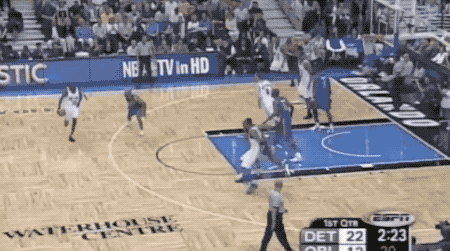
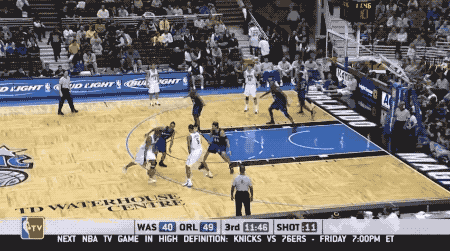
McGrady could glide around defenders off one leg, but he struggled to generate enough power to keep his body square when absorbing contact in such situations. Most of his strongest finishes came when he could plant both feet down and power up through the defender. When he tried to go up with one foot, the slightest glancing blow in mid-air caused his body to spin in all sorts of awkward directions. It’s hard to sink straight into a landing when the body isn’t close to straight.

Today’s stars built up their core muscles to prevent these bad falls. Their hips and calves are strong enough to stay centered in mid-air, even when leaping off one foot. They don’t jump as high as McGrady, but their bodies are much sturdier in mid-air, allowing them to absorb more of the landing force through their hips and calves. Compare the biomechanics on these stepbacks from McGrady and James Harden. The latter doesn’t need to twist his body or kick out his legs too far to balance himself, which is why he’s able to land safely without bending his knee over his toes.

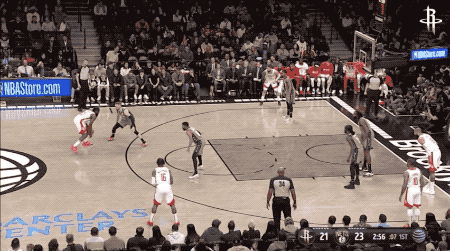
Harden has largely avoided the soft tissue and trunk injuries McGrady suffered despite having a similar game and offensive load. LeBron James has stayed remarkably healthy in large part due to his core strength. George had a freak leg injury and some shoulder issues, but has thus far avoided serious knee trouble. Kawhi insisted on a load management strategy the second his body showed signs of wear and tear and has been all the better for it. Giannis has dealt with occasional nagging issues, but never an extended absence. (Knock on wood).
To understand why, all you need to do is look at their waists and hips compared to McGrady’s. They learned from T-Mac’s biomechanic pitfalls — and his team’s inability to manage them — to perfect the path he forged first. They copied his software and improved his hardware. Now, they’re in command of the league for the foreseeable future.
They are Tracy McGrady’s legacy, and that should more than ease the pain of those injuries and early playoff defeats.



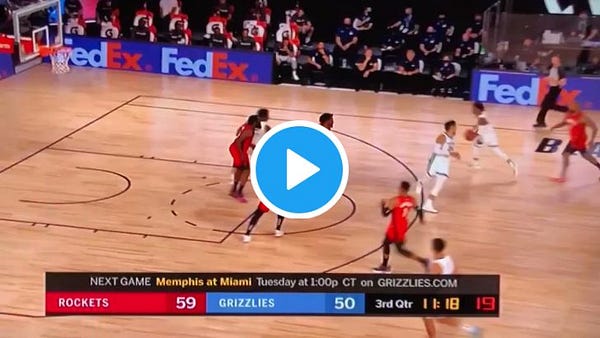
I'm a little surprised you didn't use the clip of TMac going "how you want it? I can give it to you any kind of way so how do you want it?"
Amazing read.
Cool post. But there are a lot of assumptions in it. I don't think you can assume he kicked his legs out because of a lack of core strength. You could just as easily say he kicked his legs out because it felt natural to finish the shot that way and he wasn't thinking at all about the landing; he did what he had to do to shoot the ball how he felt comfortable doing it. I've seen him topless; he had plenty of muscle in the midsection. It wouldn't be easy to plank at 6'8. As for putting an arm down when taking a seat...really? We all do that. Once again, it's nothing more than an assumption to guess the reason for it.